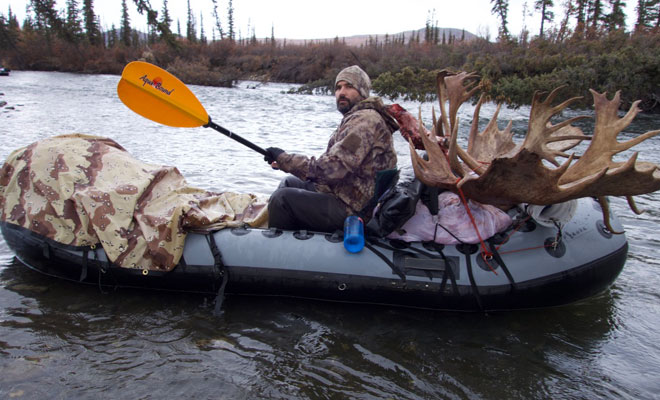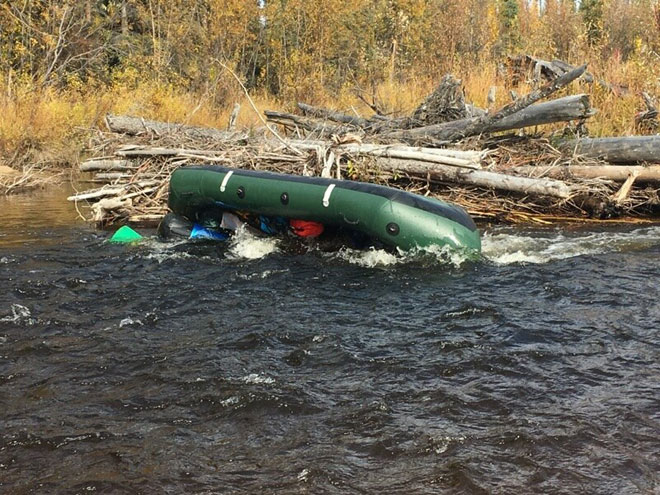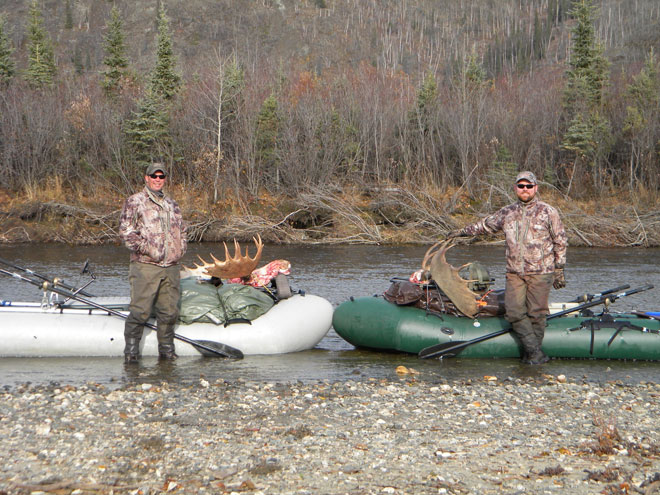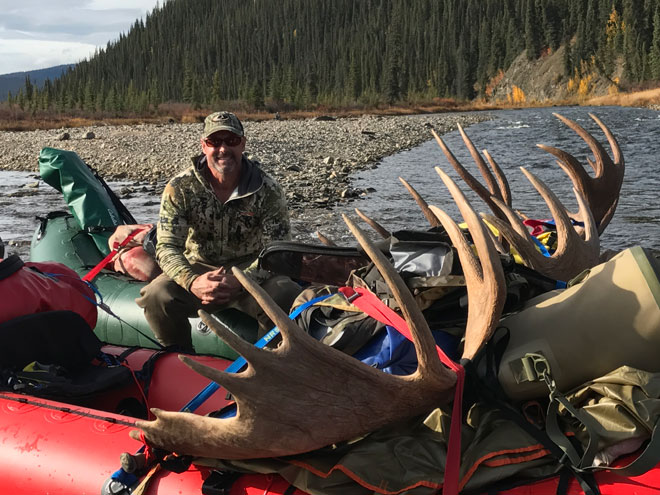 by Larry Bartlett
by Larry Bartlett
- Waders: hippers vs. chest-high
- Dry bag selection
- Floating more and hunting less
- Check your ego at the counter (think water character not antlers)
- Bring more money!
I’ve been planning do-it-yourself float hunts in Alaska for 20 years, and the lessons from hundreds of clients has revealed a list of strategic errors made by less experienced float hunters. The following five mistakes are failures in strategy and are completely avoidable.
 Waders rule on float hunts. They provide a waterproof barrier against moisture, which is pervasive and relentless on river hunts. The most common first-round planning question during Q & A sessions with my clients include choosing between hip boots and chest waders. The best fit for me is chest waders, and here’s why:
Waders rule on float hunts. They provide a waterproof barrier against moisture, which is pervasive and relentless on river hunts. The most common first-round planning question during Q & A sessions with my clients include choosing between hip boots and chest waders. The best fit for me is chest waders, and here’s why:
- Insulation insurance for my torso against wind and moisture on long, cold sitting periods both in and out of the raft.
- There’s no need for rain pants.
- Allows for unexpected water crossings that require waist-deep traverse
- A bonus feature of stocking-foot chest waders is the ability to submerge your feet in hot water for rewarming feet and core vitality.
Hip boots do none of these things. If asked what brand I recommend SIMMS.
Dry Bag selection has been a career-long quest for me. I’ve discovered the best dry bag through painful trial and error, and Watershed earns my loyalty. Every other brand and style I’ve tried in comparable weight and durability has failed miserably. Water seepage from rain or river, upside down or right side up, will find its way into the slightest security gap and ruin your day. Whether comparing roll-top duffels to waterproof zippers or any other closure style, buy Watershed and forget the rest.
 Floating more and hunting less is like driving down a country road at 3 MPH hoping for a trophy to chance out of an aspen grove for a clear shot. It may happen eventually, but not very often. When comparing data from successful and unsuccessful groups from the first decade of practice to the second decade, an enlightening trend began to emerge. Up to 40 percent higher success rates resulted from stationary camps and overlooks compared to just “floating” to look for moose. More than 70 percent of the bulls harvested by clients along rivers are shot while still-hunting (not floating). In fact, only a small percentage of bulls (<30 percent) are shot while on the drift. Remember that float hunting provides flowing access through prime hunting zones, and that highway is best used as transport between hunting camps and over looks. Hunt first, then float.
Floating more and hunting less is like driving down a country road at 3 MPH hoping for a trophy to chance out of an aspen grove for a clear shot. It may happen eventually, but not very often. When comparing data from successful and unsuccessful groups from the first decade of practice to the second decade, an enlightening trend began to emerge. Up to 40 percent higher success rates resulted from stationary camps and overlooks compared to just “floating” to look for moose. More than 70 percent of the bulls harvested by clients along rivers are shot while still-hunting (not floating). In fact, only a small percentage of bulls (<30 percent) are shot while on the drift. Remember that float hunting provides flowing access through prime hunting zones, and that highway is best used as transport between hunting camps and over looks. Hunt first, then float.
Check your ego at the ticket counter or your next Alaska river adventure will claim it. In my experience, hunters inflated by self-confidence and harvest-driven determination are those most likely to fail as a float hunter. Everything you know about hunting and navigation must be adapted to meet the demands of the river conditions and boat selection you have to work with. For example, how much weight can this boat hold before you’re dragging it downstream? That max capacity varies by watercraft design, but on day 1 the river conditions decide how much water depth your hull has to perform and the character your craft has to negotiate. Your goal is to determine what that self-imposed, maximum-allowable harvest limit must be to keep your watercraft safely afloat. Those who notch a harvest ticket before answering this major question are then served humble pie and real danger. Remind yourself that harvest-driven goals are rarely appropriate on float hunts in Alaska, as river conditions ultimately dictate the safest max load of any boat coupled with its captain’s decisive actions before and after the trigger squeeze. River character, boat selection, harvest goal…that’s the winning combination to success.
 Budget for and bring more money than you expect to cover your next float hunt, and make it cash. I’ve said this before, “hundred dollar bills dissolve problems like smoke through a key hole”! The average float hunter will spend $800 more than their allotted budget before the cookie crumbles. There are so many faucets of financial bloodletting that we simply cannot accurately budget for every circumstance or convenience. Whether in the form of food, gratuities, lodging, ticket changes, unexpected gear replacement, extra flights, or convenience fees (use your imagination), those Benjamin’s fly like dice and not boomerangs! Alaska’s hunting industry is still a cash economy, and many small businesses still prefer cash over credit.
Budget for and bring more money than you expect to cover your next float hunt, and make it cash. I’ve said this before, “hundred dollar bills dissolve problems like smoke through a key hole”! The average float hunter will spend $800 more than their allotted budget before the cookie crumbles. There are so many faucets of financial bloodletting that we simply cannot accurately budget for every circumstance or convenience. Whether in the form of food, gratuities, lodging, ticket changes, unexpected gear replacement, extra flights, or convenience fees (use your imagination), those Benjamin’s fly like dice and not boomerangs! Alaska’s hunting industry is still a cash economy, and many small businesses still prefer cash over credit.
We hope that reading this common-mistakes made by float hunters article helps you be more prepared for your float hunt. Good luck and enjoy the adventure!
Larry Bartlett is the owner of Pristine Ventures in Fairbanks who specialize in planning unguided hunting trips for clients. Larry is the author of The Complete Guide to Float Hunting Alaska and Float Dragging Alaska and the designer of the PR-49 packraft and several packraft designs.
